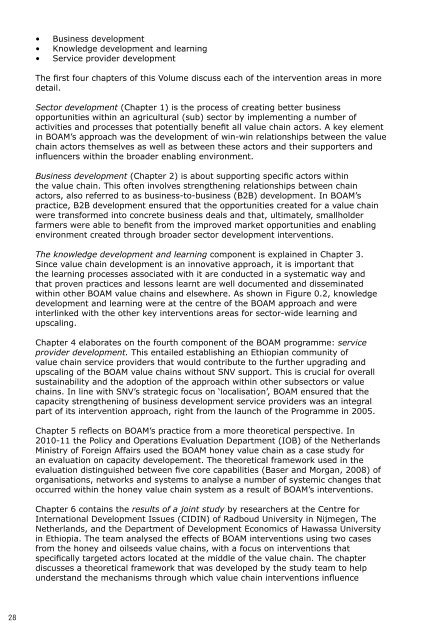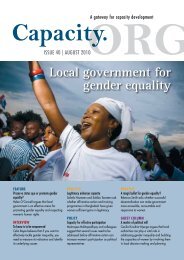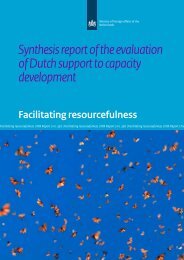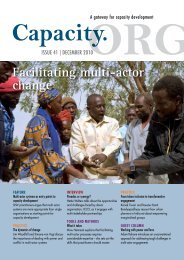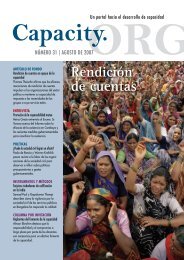Pro-Poor Value Chain Development - Capacity.org
Pro-Poor Value Chain Development - Capacity.org
Pro-Poor Value Chain Development - Capacity.org
Create successful ePaper yourself
Turn your PDF publications into a flip-book with our unique Google optimized e-Paper software.
28<br />
• Business development<br />
• Knowledge development and learning<br />
• Service provider development<br />
The first four chapters of this Volume discuss each of the intervention areas in more<br />
detail.<br />
Sector development (Chapter 1) is the process of creating better business<br />
opportunities within an agricultural (sub) sector by implementing a number of<br />
activities and processes that potentially benefit all value chain actors. A key element<br />
in BOAM’s approach was the development of win-win relationships between the value<br />
chain actors themselves as well as between these actors and their supporters and<br />
influencers within the broader enabling environment.<br />
Business development (Chapter 2) is about supporting specific actors within<br />
the value chain. This often involves strengthening relationships between chain<br />
actors, also referred to as business-to-business (B2B) development. In BOAM’s<br />
practice, B2B development ensured that the opportunities created for a value chain<br />
were transformed into concrete business deals and that, ultimately, smallholder<br />
farmers were able to benefit from the improved market opportunities and enabling<br />
environment created through broader sector development interventions.<br />
The knowledge development and learning component is explained in Chapter 3.<br />
Since value chain development is an innovative approach, it is important that<br />
the learning processes associated with it are conducted in a systematic way and<br />
that proven practices and lessons learnt are well documented and disseminated<br />
within other BOAM value chains and elsewhere. As shown in Figure 0.2, knowledge<br />
development and learning were at the centre of the BOAM approach and were<br />
interlinked with the other key interventions areas for sector-wide learning and<br />
upscaling.<br />
Chapter 4 elaborates on the fourth component of the BOAM programme: service<br />
provider development. This entailed establishing an Ethiopian community of<br />
value chain service providers that would contribute to the further upgrading and<br />
upscaling of the BOAM value chains without SNV support. This is crucial for overall<br />
sustainability and the adoption of the approach within other subsectors or value<br />
chains. In line with SNV’s strategic focus on ‘localisation’, BOAM ensured that the<br />
capacity strengthening of business development service providers was an integral<br />
part of its intervention approach, right from the launch of the <strong>Pro</strong>gramme in 2005.<br />
Chapter 5 reflects on BOAM’s practice from a more theoretical perspective. In<br />
2010-11 the Policy and Operations Evaluation Department (IOB) of the Netherlands<br />
Ministry of Foreign Affairs used the BOAM honey value chain as a case study for<br />
an evaluation on capacity developement. The theoretical framework used in the<br />
evaluation distinguished between five core capabilities (Baser and M<strong>org</strong>an, 2008) of<br />
<strong>org</strong>anisations, networks and systems to analyse a number of systemic changes that<br />
occurred within the honey value chain system as a result of BOAM’s interventions.<br />
Chapter 6 contains the results of a joint study by researchers at the Centre for<br />
International <strong>Development</strong> Issues (CIDIN) of Radboud University in Nijmegen, The<br />
Netherlands, and the Department of <strong>Development</strong> Economics of Hawassa University<br />
in Ethiopia. The team analysed the effects of BOAM interventions using two cases<br />
from the honey and oilseeds value chains, with a focus on interventions that<br />
specifically targeted actors located at the middle of the value chain. The chapter<br />
discusses a theoretical framework that was developed by the study team to help<br />
understand the mechanisms through which value chain interventions influence


